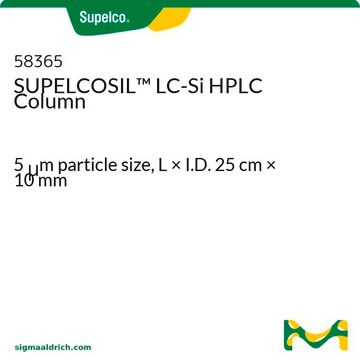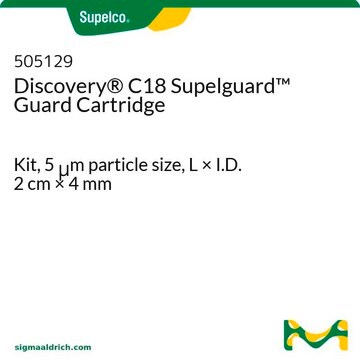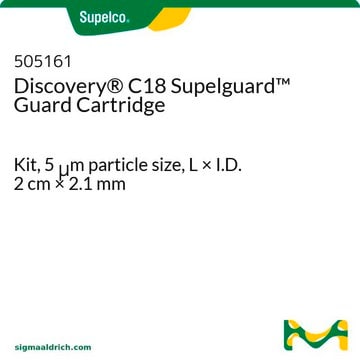504971-40
Discovery® C18 (5 µm) HPLC Columns
L × I.D. 25 cm × 4 mm, HPLC Column
Synonym(s):
C18 TM=["Discovery"] HPLC Column
About This Item
Recommended Products
product name
Discovery® C18 HPLC Column, 5 μm particle size, L × I.D. 25 cm × 4 mm
material
stainless steel column
Agency
suitable for USP L1
product line
Discovery®
feature
endcapped
manufacturer/tradename
Discovery®
packaging
1 ea of
extent of labeling
12% Carbon loading
parameter
≤70 °C temp. range
400 bar pressure (5801 psi)
technique(s)
HPLC: suitable
LC/MS: suitable
L × I.D.
25 cm × 4 mm
surface area
300 m2/g
surface coverage
3 μmol/m2
impurities
<10 ppm metals
matrix
silica gel, high purity, spherical particle platform
fully porous particle
matrix active group
C18 (octadecyl) phase
particle size
5 μm
pore size
180 Å
operating pH range
2-8
application(s)
food and beverages
separation technique
reversed phase
Looking for similar products? Visit Product Comparison Guide
Related Categories
General description
Application
- Identification, isolation and characterization of dolutegravir forced degradation products and their cytotoxicity potential.: Utilizes the Discovery® C18 HPLC Column to study the stability and degradation of the antiretroviral drug dolutegravir, crucial for ensuring drug safety and efficacy (Saida et al., 2019).
- Rapid, Refined, and Robust Method for Expression, Purification, and Characterization of Recombinant Human Amyloid beta 1-42.: This methodological study leverages the Discovery® C18 HPLC Column for the purification and analysis of amyloid beta peptides, contributing to research on Alzheimer′s disease (Prakash et al., 2019).
- Development and validation of a HPLC electrochemical detection method to measure COMT activity as a tool in drug development.: Showcases the use of the Discovery® C18 HPLC Column in developing a novel analytical method for measuring catechol-O-methyltransferase (COMT) activity, instrumental in the development of psychiatric and neurological medications (Viljoen et al., 2019).
Features and Benefits
- Excellent reproducibility
- Exceptional peak shape for basic and acidic analytes
- Stable, low-bleed LC-MS separations
- Separation of peptides and small proteins
- Lower hydrophobicity than many comparable C18 columns, providing faster analysis
Legal Information
guard cartridge
Storage Class Code
13 - Non Combustible Solids
WGK
WGK 1
Flash Point(F)
Not applicable
Flash Point(C)
Not applicable
Choose from one of the most recent versions:
Already Own This Product?
Find documentation for the products that you have recently purchased in the Document Library.
Customers Also Viewed
Related Content
Discovery C18 and C8 HPLC Columns products offered
Our team of scientists has experience in all areas of research including Life Science, Material Science, Chemical Synthesis, Chromatography, Analytical and many others.
Contact Technical Service







